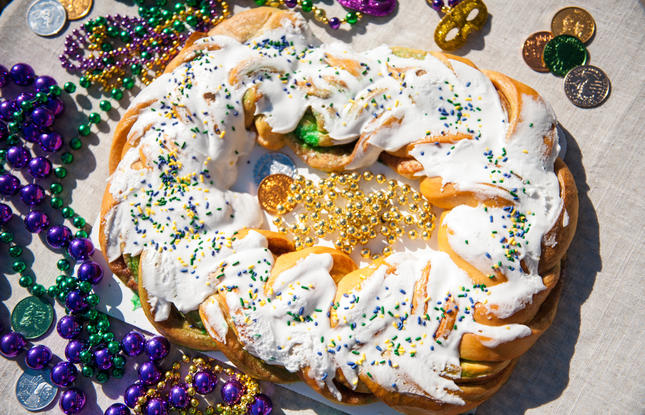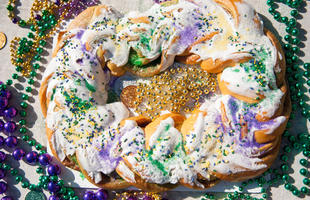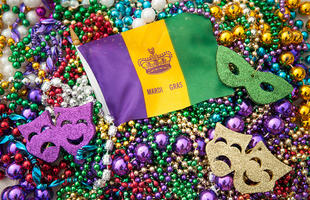King Cake: A Twelfth Night Tradition
We all love king cake. Learn why it's part of the Twelfth Night tradition.
When is Twelfth Night?
Twelfth Night marks the official opening of Carnival season, a period of masquerade balls, parties and parades culminating in the celebration of Mardi Gras. Twelfth Night can fall on either Jan. 5 or 6, depending on whether you count from Christmas Day or the day after Christmas. New Orleans celebrates Twelfth Night on Jan. 6.
Twelfth Night can also coincide with the Feast of the Epiphany, a Catholic celebration of the visit of the Magi to the Christ Child. The best part about Epiphany? It’s also the start of king cake season!
When is Mardi Gras?
Mardi Gras falls on the day before Ash Wednesday, the beginning of the Catholic penitential season of Lent. The exact date changes year-to-year, so Mardi Gras can be as early as Feb. 3 or as late as March 9, making Carnival season as short as 28 days or as long as 63 days.
Twelfth Night Celebrations in New Orleans
Several events and parades are typically scheduled on Jan. 6 in New Orleans, starting with a morning press conference and king cake party with the mayor. Representatives from all of the parades that roll in the city typically attend this event. Explore other parades and events on Twelfth Night:
- The Krewe de Jeanne d'Arc foot parade strolls through the French Quarter.
- The Phunny Phorty Phellows, the group that started the trolley tradition in 1982, rolls from the Willow Street Car Barn on the St. Charles Avenue streetcar.
- The Funky Uptown Krewe hops on its own streetcar at South Carrollton Avenue and follows the St. Charles streetcar line to Uptown.
- The city’s second-oldest Carnival organization, the Twelfth Night Revelers, present a private ball honoring debutantes. Borrowing from a centuries-old European custom, the men roll out a giant cake and distribute slices to young ladies at the ball. The lucky young woman who receives the golden bean hidden inside the cake is declared queen; the remaining women receive silver beans and serve as maids in her majesty’s court.
King Cakes Throughout History
In ancient times, tribes that survived the harsh winter celebrated by baking a crown-shaped cake, using the preceding year’s wheat. Within the cake was placed a seed, bean or nut. Later, the Romans chose a king for their festivals by drawing lots. The Catholic Church linked these ancient customs to the Feast of the Epiphany in the fourth century.
During the 17th and 18th centuries, the Roi de la Fève (King of the Bean) appeared in both art and literature in Europe, and “Twelfth Cakes” became a common annual treat in England. Twelfth Night rituals took place in Creole homes in New Orleans when its French settlers brought the gateau des rois (king cake) custom with them. In 1870, the Twelfth Night Revelers formalized the Mardi Gras connection with its first parade and ball.
King Cakes Today
You’ve probably seen one of these Twelfth Night treats in a bakery around Mardi Gras. The signature oval-shaped cinnamon brioche dough is covered in purple, gold and green-colored granulated sugar, and a small plastic baby doll is tucked inside. Custom dictates that whoever receives the tiny favor buys the next cake or gives the next party.
Sticklers for tradition won’t eat a slice of king cake before Twelfth Night, as it’s believed to be bad luck. But if you’re willing to risk it, some bakeries sell the dessert year-round. By the early 21st century, more than 1 million king cakes were being consumed locally each year, with another 75,000 shipped out of state via overnight couriers.
Top Places to Buy King Cake in Louisiana
- New Orleans: Manny Randazzo King Cakes, La Boulangerie, Antoine's, Dong Phuong Bakery
- Lafayette: Keller's Bakery, Poupart Bakery, Great Harvest Bread Co.
- Alexandria: Atwood's Bakery, Sweet Joy Bakery
- Baton Rouge: Gambino's Bakery, The Ambrosia Bakery, Eloise Market and Cakery
Arthur Hardy is a Carnival expert and Mardi Gras historian from New Orleans, Louisiana. He is the publisher/writer of Arthur Hardy's Mardi Gras Guide.



